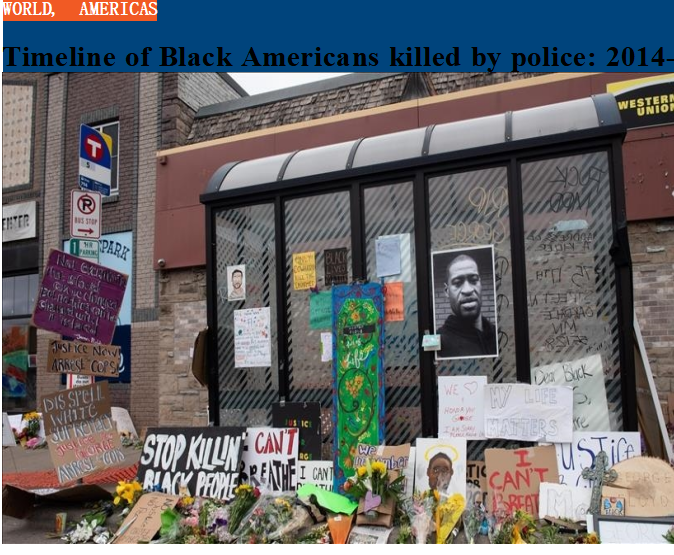Police shootings Black Africans in the United States by race and nation

There are several incorrect categorizations of police shootings in the NVSS data. The NVSS did not report 17 100 of the 30 800 deaths that we projected would occur between 1980 and 2018. The number of black non-Hispanic fatalities was significantly underreported. According to estimates, between 1980 and 2019, the age-standardized mortality rate from police violence for non-Hispanic black individuals was 0.69 (95 % confidence interval: 0.67-0.71) per 100,000 people [4-7].
According to estimates, the age-standardized mortality rate of police violence decreased between 1980 and 2019 by 32.0 percent (95% UI: 15.3 to 46.5) and 16.9% (1.7 to 31.4), respectively. However, there were consistently significant racial disparities in police violence during the whole period from 1980 to 2019. While the District of Columbia has the lowest rate, Oklahoma has one of the worst rates of violent crime against non-Hispanic Black Americans in the country [4, 8-10].
According to the National Violent Crime Survey, 55% of our estimated deaths from police violence between 1980 and 2018 were incorrectly identified and underreported. Legal action usually causes the death certification system to underreport deaths. Systemic racism is mostly to blame for the disproportionate amount of police violence against Black Americans [11, 12].
Out of 1147 fatalities in 2017, 13 events led to charges being brought against officers, according to Mapping Police Violence. This research does not calculate or examine the non-fatal injuries that police officers inflict. Open-source data collection is necessary to completely comprehend the extent of police violence [13-15].
In summary Black indigenous people in the USA bear a disproportionate share of the cost of deaths from police violence. According to estimates, between 1980 and 2019, the age-standardized police violence fatality rate for non-Hispanic black people was 0.69 (95%) per 100,000 individuals. 13 occurrences out of 1147 fatalities in 2017 gave rise to charges against officers, according to Mapping Police Violence.
References
[1] J. M. Metzl and K. T. MacLeish, “Mental illness, mass shootings, and the politics of American firearms,” American journal of public health, vol. 105, no. 2, pp. 240-249, 2015.
[2] A. Graham, M. Haner, M. M. Sloan, F. T. Cullen, T. C. Kulig, and C. L. Jonson, “Race and worrying about police brutality: The hidden injuries of minority status in America,” Victims & Offenders, vol. 15, no. 5, pp. 549-573, 2020.
[3] C. E. Menifield, G. Shin, and L. Strother, “Do white law enforcement officers target minority suspects?,” Public Administration Review, vol. 79, no. 1, pp. 56-68, 2019.
[4] G. P. V. U. S. Collaborators, “Fatal police violence by race and state in the USA, 1980–2019: a network meta-regression,” The Lancet, vol. 398, no. 10307, pp. 1239-1255, 2021.
[5] F. R. Benton, “The Effect of Police Accreditation on Organization Arrest-related Deaths: A Comparative Empirical Examination,” Sam Houston State University, 2019.
[6] M.-J. Schneider, Introduction to public health. Jones & Bartlett Learning, 2020.
[7] K. Cheng, The stolen lives project online: A digital humanities project. St. John’s University (New York), 2018.
[8] A. A. Braga, R. K. Brunson, and K. M. Drakulich, “Race, place, and effective policing,” Annual review of sociology, vol. 45, no. 1, pp. 535-555, 2019.
[9] R. J. Sampson, “Neighbourhood effects and beyond: Explaining the paradoxes of inequality in the changing American metropolis,” Urban Studies, vol. 56, no. 1, pp. 3-32, 2019.
[10] S. A. Schwartz, “Police brutality and racism in America,” Explore (New York, NY), vol. 16, no. 5, p. 280, 2020.
[11] R. T. Webb, P. Qin, H. Stevens, P. B. Mortensen, L. Appleby, and J. Shaw, “National study of suicide in all people with a criminal justice history,” Archives of general psychiatry, vol. 68, no. 6, pp. 591-599, 2011.
[12] E. E. Fridel, K. G. Sheppard, and G. M. Zimmerman, “Integrating the literature on police use of deadly force and police lethal victimization: How does place impact fatal police–citizen encounters?,” Journal of Quantitative Criminology, vol. 36, no. 4, pp. 957-992, 2020.
[13] A. G. Ferguson, “Policing predictive policing,” Wash. UL Rev., vol. 94, p. 1109, 2016.
[14] T. Campbell, “Black Lives Matter’s effect on police lethal use-of-force,” Available at SSRN 3767097, 2021.
[15] A. Balbus, “When a Loved One is Killed by Law Enforcement: The Psychological Experience of Bereaved Children and Caregivers,” The Wright Institute, 2019.
